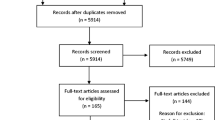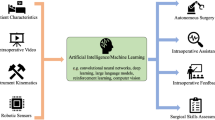Abstract
Purpose
Minimally Invasive Surgery (MIS) is a widely used surgical technique that requires a long training process due to its difficulty and complexity. We developed an Augmented Reality Haptic (ARH) System based on electromagnetic tracking devices for use in creation training models (computer-enhanced trainers), in computer-assisted surgery or telemanipulation applications.
Method
The ARH system consists currently in a Linux driver and a calibration protocol to acquire the tooltip position of conventional laparoscopic tools in real time. A Polhemus Isotrack® II was used to track surgical endoscopic tooltip movements. The receiver was mounted on the tool handle in order to measure laparoscopic tools positions without complex modifications. Two validation tests were done to guarantee the proper functioning of the ARH system in a MIS environment. The first one checks the driver operation and the second measures the accuracy and reliability of the tooltip pose estimation process.
Results
Jitter and orientation errors for the first test were 2.00±0.10 and 2.00±0.09 mm, respectively. Relative position error of 0.25±0.06 cm for a distance of 5 cm was found. Jitter error for the second test was 127 ± 60, 117 ± 40 and 122 ± 39 mm in Z, Y and X rotations, respectively.
Conclusions
Results obtained with the ARH system are sufficiently accurate for use in MIS training. A supplementary correction procedure would be necessary to use this ARH system in computer-assisted surgery or telemanipulation.
Similar content being viewed by others
References
Usón J, Sánchez F, Pascual S, Climent S (2007) Formación en Cirugía Laparoscópica Paso a Paso. Centro de Cirugía de Mínima Invasión, Cáceres, Spain
Fried GM (2008) FLS assessment of competency using simulated laparoscopic task. J Gastrointest Surg 12(2): 210–212
Kanumuri P, Ganai S, Wohaibi EM, Bush RW, Grow DR, Seymour NE (2008) Virtual reality and computer-enhanced training devices equally improve laparoscopic surgical skill in novices. JSLS 12(3): 219–226
Fichera A, Prachand V, Kives S, Levine R, Hasson H (2005) Physical reality simulation for training of laparoscopists in the 21st century. A multispecialty, multi-institutional study. JSLS 9(2): 125–129
Madan AK, Frantzides CT, Tebbit C, Shervin N (2005) Self-reported vs observed scores in laparoscopic skills training. Surg Endosc 19: 670–672
Munz Y, Kumar BD, Moorthy K, Bann S, Darzi A (2004) Laparoscopic virtual reality and box trainers. Is one superior to the other?. Surgical Endoscopic 18: 485–494
Fellinger EK, Ganey ME, Gallagher AG, Scott DJ, Bush RW, Seymour NE (2006) Complex laparoscopic task performance on two new computer-based skills training devices. Surg Endosc 20: S363
Botden SM, Buzink SN, Schijven MP, Jakimowicz JJ (2007) Augmented versus virtual reality laparoscopic simulation: what is the difference? a comparison of the promis augmented reality laparoscopic simulator versus lapsim virtual reality laparoscopic simulator. World J Surg 31(4): 764–772
Madan AK, Frantzides CT, Tebbit CL, Quiros RM (2005) Participant’s opinions of laparoscopic trainers during basic laparoscopic training courses. Am J Surg 189: 758–761
Waxberg SL, Goodell KH, Avgerinos DV Schwaitzberg SD, Cao CGL (2004) Evaluation of physical versus virtual surgical training simulators. Proce HFES 48th Annu Meet 48: 1675–1679
Young D, Slevin F, Cassidy D, Ryan D (2007) Objective measurement of FLS precission cutting task. Society of American Gastrointestinal and Endoscopic Surgeons (SAGES), ETP057
English J, Chang CY, Tardella N, Hu J (2005) A vision-based surgical tool tracking approach for untethered surgery simulation and training. Stud Health Technol Inform 111: 126–132
Dewan M, Marayong P, Okamura AM, Hager GD (2004) Vision-based assistance for ophthalmic microsurgery. Med Image Comput Comput Assist Interv 2: 49–57
Fischer J, Eichler M, Bartz D, Straser W (2006) Model-based hybrid tracking for medical augmented reality. Eurographics Symp Virtual Environ
Doignon C, Nageotte F, Maurin B, Krupa A (2008) Pose estimation and feature tracking for robot assisted surgery with medical imaging. In: Kragic D, Kyrik V (eds) Unifying perspectives in computational and robot vision. Springer, US
Lizarraga CA, Ortega LR, Urbina BJ, Rodríguez O (2008) Visión artificial para detección y ubicación espacial de instrumental laparoscópico. In: Cardona A, Storti M, Zuppa C (eds) Mecánica Computacional vol XXVII. San Luis, Argentina, pp 3627–3637
Chmarra MK, Grimbergen CA, Dankelman J (2007) Systems for tracking minimally invasive surgical instruments. Minim Invasive Ther Allied Technol 16(6): 328–340
Gunther S, Rosen J, Hannaford B, Sinanan M (2007) The red DRAGON: a multi-modality system for simulation and training in minimally invasive surgery. Stud Health Technol Inform 125: 149–154
Feng C, Haniffa H, Rozenblit J, Hamilton A, Salkini M (2006) Surgical training and performance assessment using a motion tracking system. Int Med Model Multiconference Proc 647–652
Diaz CA, Posada D, Trefftz H, Bernal J (2008) Development of a surgical simulator to training laparoscopic procedures. Int J Educa Inf Technol 2(1): 95–110
Martinez H, Mucha D, Kosmecki B, Kruger T (2008) Calibration method for electromagnetic tracked instruments in clinical applications. Int J Comput Assist Radiol Surg 3(1): 111–113
Birch DW, Bonjer HJ, Crossley C, Burnett G, Gara C, Gomes A, Hagen J, Maciver AG, Mercer CD, Panton ON, Schlachta CM, Smith AJ, Warnock GL (2009) Canadian consensus conference on the development of training and practice standards in advanced minimally invasive surgery. Can J Surg 52(4): 321–327
Detmer PR, Bashein G, Hodges T, Beach KW, Filer EP, Burns DH, Strandness DE (1994) 3D ultrasound image feature localization based on magnetic scan head tracking: in vitro calibration and validation. Ultrasound Med Biol 20: 923–936
Hartov A, Eisner SD, David MS, Roberts W, Paulsen KD, Platenik BS, Miga MI (1999) Error analysis for a free-hand three dimensional ultrasound system for Navigation. Neurosurg Focus 6(3): E7
Jannin P, Korb W (2008) Assessment of image-guided interventions. In: Peters T, Cleary K (eds) Image-guided interventions. Springer, US, pp 531–549
Hummel JB, Figl ML, Kang Y, Maurer C, Birkfellner WW, Bergmann H, Shahidi R (2005) Design and application of an assessment protocol for electromagnetic tracking systems. Med Phys 32(7): 2371–2379
Schneider M, Stevens C (2007) Development and testing of a new magnetic-tracking device for image guidance. Medical imaging 2007: visualization and image-guided procedures. In: Cleary K, Miga M (eds) Proceedings of the SPIE 6509:650901
Schicho K, Figl M, Donat M, Birkfellner W, Seemann R, Wagner A, Bergmann H, Ewers R (2005) Stability of miniature electromagnetic tracking systems. Phys Med Biol 50(9): 2089–2098
Xeroulis G, Dubrowski A, Leslie K (2009) Simulation in laparoscopic surgery: a concurrent validity study for FLS. Surg Endosc 3(1): 161–165
Hayter MA, Friedman Z, Bould MD, Hanlon JG, Katznelson R, Borges B, Naik VN (2009) Validation of the Imperial College Surgical Assessment Device (ICSAD) for labour epidural placement. Can J Anaesth 56(6): 419–426
Ezra DG, Aggarwal R, Michaelides M, Okhravi N, Verma S, Benjamin L, Bloom P, Darzi A, Sullivan P (2009) Skills acquisition and assessment after a microsurgical skills course for ophthalmology residents. Ophthalmology 116(2): 257–262
Grober ED, Roberts M, Shin EJ, Mahdi M, Bacal V (2010) Intraoperative assessment of technical skills on live patients using economy of hand motion: establishing learning curves of surgical compentence. Am J Surg 199: 81–85
Moorthy K, Munz Y, Sarker SK, Darzi A (2003) Objective assessment of technical skills in surgery. Br Med J 327: 1032–1037
McClusky DA, Smith CD (2008) Design and development of a surgical skills simulation curriculum. World J Surg 32: 171–181
Lombardo JC, Cani MP, Neyret F (1999) Real-time collision detection for virtual surgery. In: Computer Animation. p 82
Teschner M, Kimmerle S, Heidelberger B, Zachmann G, Raghupathi L, Fuhrmann A, Cani MP, Faure F, Magnenat-Thalmann N, Strasser W, Volino P (2004) Collision detection for deformable objects. Comput Graph 23(3): 1–22
Kockara S, Halic T, Bayrak C, Iqbal K, Rowe RA (2009) Contact detection algorithms. J comput 4(10): 1053–1063
Fried GM, Feldman LS (2008) Objective assessment of technical performance. World J Surg 32(2): 156–160
Nistor V, Allen B, Dutson E, Faloutsos P, Carman GP (2007) Immersive training and mentoring for laparoscopic surgery. Nanosensors, microsensors, and biosensors and systems 2007. Proc SPIE 6528:65280Q1–65280Q11
Sánchez-Margallo FM, Sánchez MA, Pérez FJ, Pagador JB, Mateos J, Bustos P, Díaz-Güemes I, Moyano JL, Correa L, Usón J (2009) Dispositivo Electrónico para el Entrenamiento de Técnicas Endoquirúrgicas (DEETE)®: validación clínica subjetiva, vol XVII. Reunión Nacional de Cirugía
Author information
Authors and Affiliations
Corresponding author
Rights and permissions
About this article
Cite this article
Pagador, J.B., Sánchez, L.F., Sánchez, J.A. et al. Augmented reality haptic (ARH): an approach of electromagnetic tracking in minimally invasive surgery. Int J CARS 6, 257–263 (2011). https://doi.org/10.1007/s11548-010-0501-0
Received:
Accepted:
Published:
Issue Date:
DOI: https://doi.org/10.1007/s11548-010-0501-0




